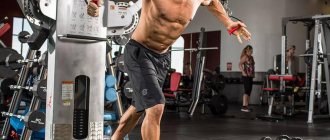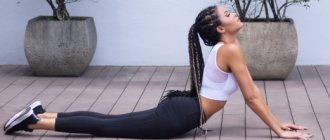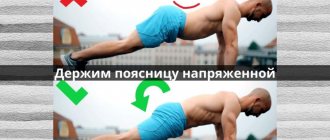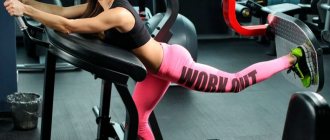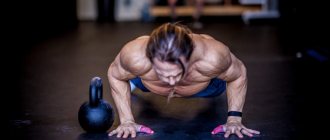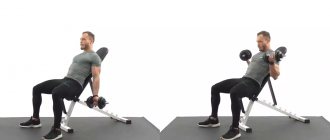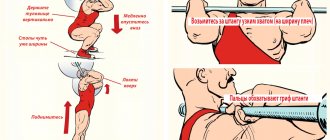September 19, 2022 Admin Home page » Tips and tricks
Learn how to increase strength, build muscle, and burn excess body fat with a simple workout routine.
Many guys played the sports game Ladder in childhood; it is usually used in pull-ups on the horizontal bar, push-ups on parallel bars and from the floor.
However, you rarely see it performed in gyms, although it would be useful to introduce it into the workout for variety in order to avoid a monotonous exercise schedule.
LADDER is an exercise performed with your own body weight or with the same weight by 2 or more people. The sets are performed immediately after the last person has completed the exercise.
What is the “Ladder” exercise?
This name refers to the complex performance of an exercise, in which each subsequent series is performed with a greater load than the previous one, due to an increase in the number of repetitions. For example, an athlete performed one push-up on the uneven bars, after a short rest he already needs to perform two push-ups, then three, and so on. The name “Ladder” can be understood intuitively, since the role of “steps” in it is played by the constantly increasing number of repetitions of the physical exercise.
You may be interested in: What you need for fitness: 10 tips for a beginner
Note that the type of training under consideration differs from the so-called Pyramid, since in the latter the weight of the sports equipment increases with each subsequent exercise, while in the “Ladder” only the number of repetitions increases, while the weight remains unchanged.
Pull-up program
The basis of any method of increasing the number of pull-ups is the progression of the load. Without progression of the load there will be no result. Imagine that you constantly perform the same number of repetitions and sets in every workout. What do you think will happen? That's right, you will be marking time in one place. Therefore, any pull-up program or method for increasing the number of pull-ups is based on the principle of load progression.
One of the simplest and most effective ways to increase the number of pull-ups on the horizontal bar is to follow a pull-up program, according to which you will perform 2 more pull-ups each week than the previous one (see figure).
Please note that this pull-up program is intended for those who can initially do at least 15 pull-ups in one set. However, you can easily adjust this training program to suit you.
I hope now you know how to increase the number of pull-ups on the horizontal bar. It’s up to you to choose which pull-up method or program to use for this. I wish you good luck and speedy achievement of your goal, friends!
What types of “Ladder” are there?
The above definition refers to the so-called ascending “Ladder”, since the number of repetitions in each series increases. If you start performing a physical complex with a series of a large number of repetitions (for example, 10), and then reduce this number with each subsequent approach, then they talk about a descending “Ladder”.
Any other variations of this training complex are a combination of the ascending and descending “Ladder”. Thus, a complex is often performed in which the number of repetitions of an exercise in a series is first increased to a certain value, and then reduced to the original number. Another type of “Ladder” is multiple repetitions up and down; this option is usually denoted by the Latin letter W indicating the maximum number of “steps”, for example, W8.
The “Ladder” exercise is most often used during exercises on the horizontal bar, during push-ups, and also during squats. Let's consider each of these types of exercises, taking into account its implementation in the form of a “Ladder”.
Instructions for assembling a modular staircase with your own hands
Walking on a treadmill for weight loss: how to walk correctly for benefits and effectiveness?
You will need round metal pipes with thick walls. It is unlikely that you will be able to make them yourself, so it is better to purchase them from a specialized organization. These pipes will go to the modules.
You will also need good strong pipes from which you will make load-bearing supports.
You can cut the steps yourself from wood or order them from an organization working in this profile. The same applies to blanks for balusters and railings. You can cut them yourself or buy ready-made elements in the store. In addition, you will need a welding machine, as well as cement, water and sand to make concrete mortar.
The process of installing the frame of a modular system
- Cut the pipes according to the existing dimensions using a grinder.
- Weld the rectangular corrugated pipe to the round one on both sides of the cut, tighten it with bolts. This will provide the structure with the necessary strength.
- Insert a piece of thin pipe into a thick one and tighten it with bolts.
- According to this scheme, make the required number of modules. The finishing and starting modules will be slightly different. A metal platform should be additionally welded to them, with the help of which the module will be attached to the ceiling with anchors.
Installation of a modular staircase
- Lubricate the inside of the modules with oil or WD-40.
- Place the starter module on the floor with plywood or corrugated cardboard underneath it.
- Insert the elements one by one, as if you were assembling a column. Fix the finishing module so that the last step is level with the floor of the second floor. For work, use a building level.
- Begin to carefully push the frame apart. You will not damage your existing floor covering if, as we recommended above, you lay plywood under the lower module. Give the frame the desired shape.
- Next, we proceed to the manufacture of vertical racks. It will be very good if you mount them on the foundation. Mix cement and sand in proportions 1:2. Fill the pits with the resulting concrete mixture, having previously installed supports there. If it is not possible to pour a foundation, attach the launch module platform to the floor using several anchors.
- After the concrete solution has dried, attach the assembled metal frame to the vertical supports using bolts.
- The last thing to attach is the starting module. If your floor is concrete, do this with anchors. If the frame is installed on a wooden surface, use wood grouse with threads similar to those of screws.
Installation of steps
- Using a building level, screw the flanges to secure the steps to the assembled modules.
- Lay the steps on the flange and mark the locations for fasteners.
- Drill holes at the indicated points.
- Attach the steps to the flanges using capsails or other fasteners.
Installation of handrails
If you purchased ready-made balusters in the store that have a diameter of 25 mm, follow these instructions:
- Measure 5 cm from the edge of the step, drill a hole equal to the diameter of the baluster.
- Insert the baluster into this hole and level it too.
- On the bottom step, mark the point where the center of the baluster falls. And drill a hole with a diameter of 5 mm. It is necessary for fastening with a bolt.
- Insert the baluster into the workpiece and tighten the bolt on the bottom step.
- Install all balusters in the same way.
- Attach the handrail to the balusters with self-tapping screws. Ready-made models are equipped with special grooves for this.
"Ladder" on the horizontal bar
Perhaps this is the most popular sports equipment with which the training complex in question is practiced. To perform the “Ladder” exercise on the horizontal bar, in addition to the crossbar itself, several athletes are needed (2-6), ideally 3-4.
It is performed as follows: the first athlete does one pull-up, then the second athlete also does one pull-up and so on in turn until it reaches the first athlete again, then he does two pull-ups, then the second athlete does this number pull-ups, third and so on. In this case, the opponents need to discuss in advance the issue of the maximum number of pull-ups (“steps of the ladder”). The winner is the one who completes the exercise according to the described rules.
Note that in the described version of the “Ladder” for training on the horizontal bar, the athlete rests until his turn comes, which is why the number of opponents 3-4 is optimal, in any other cases the rest time will be either too short or too big.
In the same way, you can perform the descending “Ladder” or its other types.
A variation of the exercise in question on the bar is to use different grips (bottom, top, wide, narrow, etc.) on each subsequent “step”. Different grips help to work different muscle groups. When performing pull-ups, the muscles of the arms (biceps, forearms) and back are mainly involved in the work.
Five simple exercises on the stairs for those who want “legs like Jennifer’s”
Slender legs are not always a gift of nature, but this can be achieved through proper and diligent training. Summer is the time for shorts and short skirts, but not every woman will dare to afford a mini. If nature has not endowed you with slender legs, do not be discouraged: even the owner of the sexiest and most seductive legs in the world, Jennifer Aniston, achieved success in this field only thanks to proper and diligent training. Today our fitness expert Alina Nasyrova will show you five simple exercises, after which it will be impossible to take your eyes off your legs. For an outdoor workout, you'll need a ladder in your favorite park. But if your work schedule doesn’t allow you to leave the walls of the business center, then you can turn the staircase into a 10-minute workout area at lunchtime. A light workout with the help of a ladder will tighten your figure, make your buttocks firm, and also strengthen your cardiovascular system. Moreover, the workout is extremely energy-intensive and will help you burn off the extra calories you accidentally ate at lunch. Pay attention to the picture. When performing the exercises, all leg muscles are involved: buttocks, front and back thighs, calf muscles. We perform the first exercise as a warm-up. We stand facing the stairs. At a moderate pace we go up 12 steps (or 1 floor) and at a fast pace we go down. We perform 10 stair climbs. Now let's complicate the task a little. We stand with our right side to the stairs and begin to climb up, starting with our left foot, step over the step where our right foot stands. Having reached the end of the distance, return down quickly. The next upward lift is carried out with the left side. We perform 10 climbs up the stairs (5 climbs on each side). An alternative to the classic “moving lunge” exercise. We stand facing the stairs. We step with our right foot diagonally through 2-3 steps, bend our knees, pause for a split second at the lowest point, straighten our legs and pull our left leg towards our right. Perform the next lunge to the left with the left foot. Having reached the end of the distance, return to the beginning at a brisk pace. We perform 10 stair climbs. Let’s complicate the task and add load on the buttocks: when performing a new exercise, we will have to climb the stairs in a half-squat position. We stand facing the stairs, feet shoulder-width apart. We perform a classic squat, fix the position at the lowest point and climb the stairs. Having reached the top point, straighten your legs and return down at your usual fast pace. We perform 10 stair climbs. At least one exercise should be devoted to working the calf muscles. We stand facing the stairs, step up the step. Leave your heels in the air and toes on the step. Your task will be to rise on your toes and lower yourself down, trying to pull your heels down, thereby stretching the muscles of your lower leg. We perform the exercise 3 sets of 20 lifts. comfortable clothes, shoes and a hat if you train outside in the open air; convenient staircase. A staircase is ideal in business centers or multi-storey buildings. Outdoor stairs are also a great option; first, check the integrity of the ladder - whether there are any chips or debris on it that could interfere with the exercises; During any training, you should have a bottle of water with you to avoid dehydration.
"Ladder" for push-ups
The “Ladder” exercise on the floor, which is performed in the form of push-ups while lying down, is less popular than a similar complex on the crossbar, however, it can also be used for training purposes. The essence is the same, that is, a gradual increase in the number of push-ups. It is also desirable to have 3-4 opponents, to maintain a competitive spirit and the most convenient time period for rest between series.
Just like on the horizontal bar, for this “Ladder” you can practice different types of push-ups, of which there are more than 100 (narrow or wide hand placement, push-ups with clap, on one arm and others).
"Add-on"
This game requires several participants - 3 or more. Players approach the projectile one by one. The first turnstile performs some kind of movement - hanging on the bar, lifting the legs, pulling up. The person following him repeats this movement and adds a new one. The task of each athlete is to repeat the entire sequence of elements. The one who fails to do this is eliminated from the game.
To make the game useful and exciting, you must adhere to the following rules:
- At the initial stage (2-3 circles), you should use the simplest elements, gradually introducing more complex ones into the game.
- Players must take into account the level of training of their opponents and not offer elements that require technical training at a professional level. Not every participant will be able to repeat the stretching or flexibility exercise, which is why he will have to leave the game.
- For a static element to be counted, it must be fixed for at least 3 seconds.
- Each participant must repeat the set of exercises in the same order, and also monitor the accuracy of the amplitude of the element. If the previous participant performed a right angle with his legs, then the next one cannot allow a large deviation in any direction.
- Spectators and participants in the game can help the turnstile maker by suggesting the order of performing the elements.
"Ladder" for legs
It is very rare to find an athlete who practices the “Ladder” exercise for the legs. Here, as in previous cases, various variations in the implementation of the physical complex are possible. Interestingly, it is customary to perform squats differently than a similar exercise with push-ups or pull-ups.
It is done like this: the athlete gets into the starting position for performing squats and does one repetition, counts a second, then does two repetitions, counts two seconds, does three squats, and so on. That is, the more squats are performed, the more the athlete rests between series.
A little about the features of modular stairs
Elliptical trainer: what is it for, pros and cons, effectiveness for weight loss
A modular staircase is a structure made of similar parts connected to each other. This system forms a chain stringer, which is a frame that bears the main load.
In addition, additional supporting elements are used:
- central post, if the structure is screw,
- supporting vertical beams, which are installed in straight and rotary structures every 1.5 m or more often,
- or wall mounting, if the latter is permanent and has a good level of strength.
Keep in mind that modular stairs can become loose over time. Therefore, at least once every six months it is necessary to check the reliability of all connections and, if necessary, tighten them additionally.
What is the benefit of “Ladder”?
In addition to the fact that this complex is interesting to perform when there are several opponents, with the help of the “Ladder” you can pump up the corresponding muscle groups well. The fact is that minimal rest periods between each “step” contribute to a significant increase in the load on the body’s muscles. In addition, a constant increase (decrease) in the number of repetitions of an exercise does not allow the muscles to get used to the same type of load, and therefore does not allow them to “stagnate”. In this understanding, “Ladder” training resembles supersets, that is, performing several exercises in a row with minimal rest between them.
O can be performed by one athlete, but in this case he will have to independently control the rest time between approaches.
Materials for the bowstring
Euphorbia for weight loss: the benefits and effectiveness of the drink at home
The string for the stairs can be wooden, metal or reinforced concrete.
Bowstrings can be of 3 types
Tree
Despite the variety of design solutions and building materials, wood is the most popular in the manufacture of support beams. In specialized stores you can increasingly find bent, glued blanks for mounting spiral wooden staircases on strings. And simple support strips for straight single-flight structures can be easily made with your own hands.
In the manufacture of the main elements of the staircase, hard types of wood are used:
pine: the advantage of pine strings for stairs is its low cost. Treated wood has various shades of color: from almost white to light brown
When choosing a material, you need to pay attention to the number of knots and moisture content of the wood. It is not recommended to use pine conifers to make treads because they have low wear resistance; larch: the second most popular material
It has the same hardness as pine, is well processed, and is more variable in the choice of colors, but there are also disadvantages. Larch is difficult to dry properly; the wood contains a lot of resin and is not resistant to mechanical damage; ash: a very durable wood, ideal for both partition support strips and treads. Ash has a fine-grained structure with a unique pattern of annual rings. The wood is easy to process, but does not like moisture, so it is recommended for the manufacture of internal stairs; Beech: ideal for the production of all staircase elements. Despite its hardness, the material is easy to process and has a delicate light pink color. The structure is fine-grained, with small veins. The wood is resistant to cracking, but just like ash, it does not like high humidity; oak: this material is the last in the line of recommended for the manufacture of load-bearing elements, because it is considered the best. The color of the wood varies from light yellow to brown and tends to darken over time. Only elite designs are made with oak staircase strings, designed to decorate interiors with a touch of aristocracy.
Metal
In order to carry out roofing work on the roof of a country house, you will need a metal ladder. The three-flight channel design has never been better suited for this purpose. Folding attic and extension ladders are the most prominent representatives of budget metal structures. The material for their manufacture is aluminum.
Recently, metal stairs are increasingly used to combine levels in private homes. They are stronger than wooden ones, but lighter than reinforced concrete buildings. The support bar is usually made of sheet steel or channels. The corners serve as the basis for the steps. Treads can be glass or wood, such as oak. The advantage of metal is that it can be used to make a structure of any shape, but the cost will be much higher than its wooden counterpart, and it is impossible to make it yourself.
Reinforced concrete
Concrete structures are quite massive and heavy in production technology, but the final product is original. Blanks for such stairs are made from monolithic concrete in accordance with the individual design of the room. A pre-made string for the staircase and the main components for it are brought to the site and installed step by step in separate fragments. You shouldn’t even think about making a reinforced concrete structure with your own hands, because this requires not only appropriate skills, but also special equipment.
Stair push-ups
Choose an angle at which you can perform push-ups correctly. Hands should be slightly wider than shoulders, palms turned slightly to the sides. When doing push-ups, the angle between your elbows and your body should be approximately 45 degrees.
Make sure that the body forms one straight line, not only in the starting position, but also during movement: the pelvis should not protrude back, the back should be straight without bending in the lower back.
Complete 10 reps.
If you find this option too easy, you can make the push-ups more difficult by clapping or doing incline push-ups (with your legs higher than your arms).
